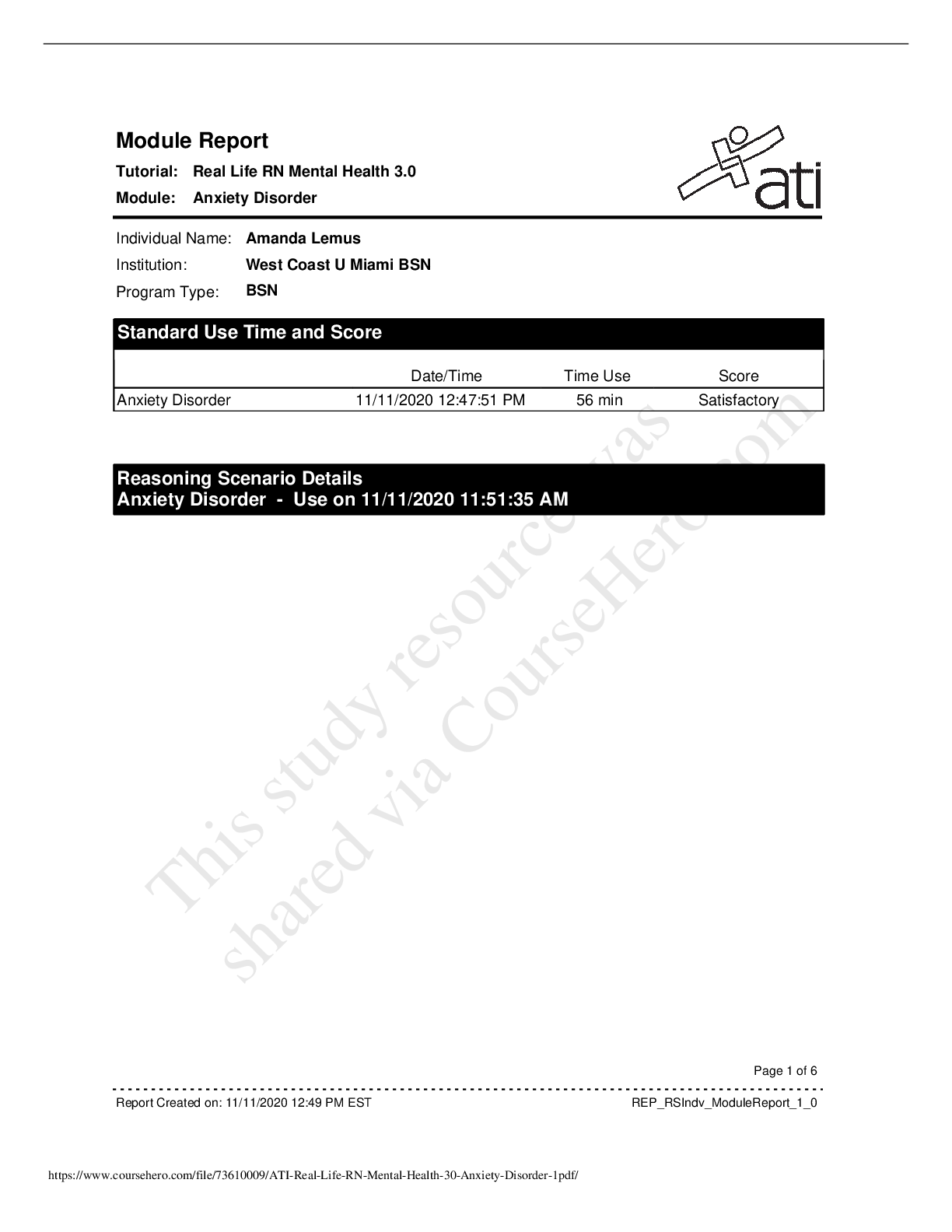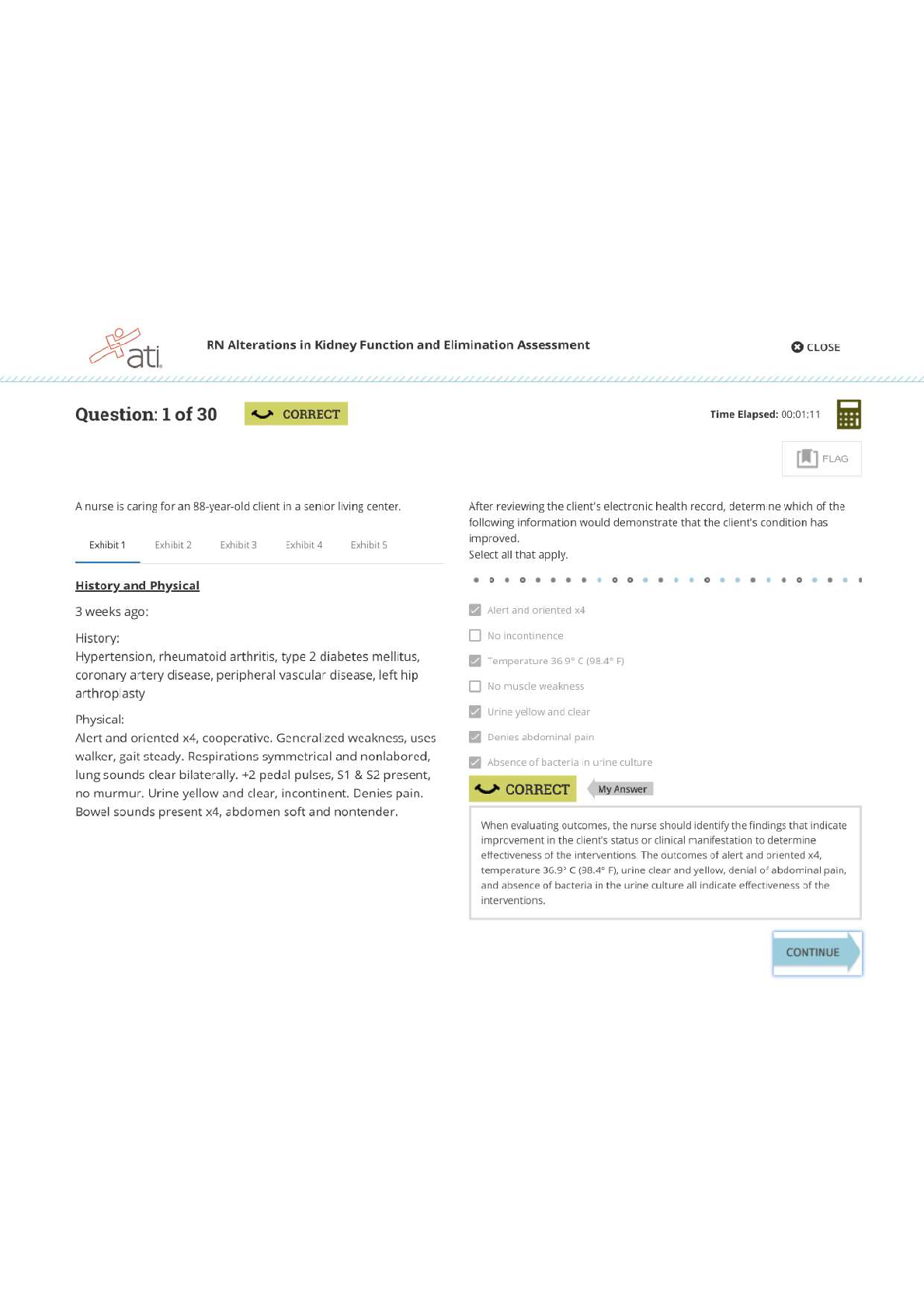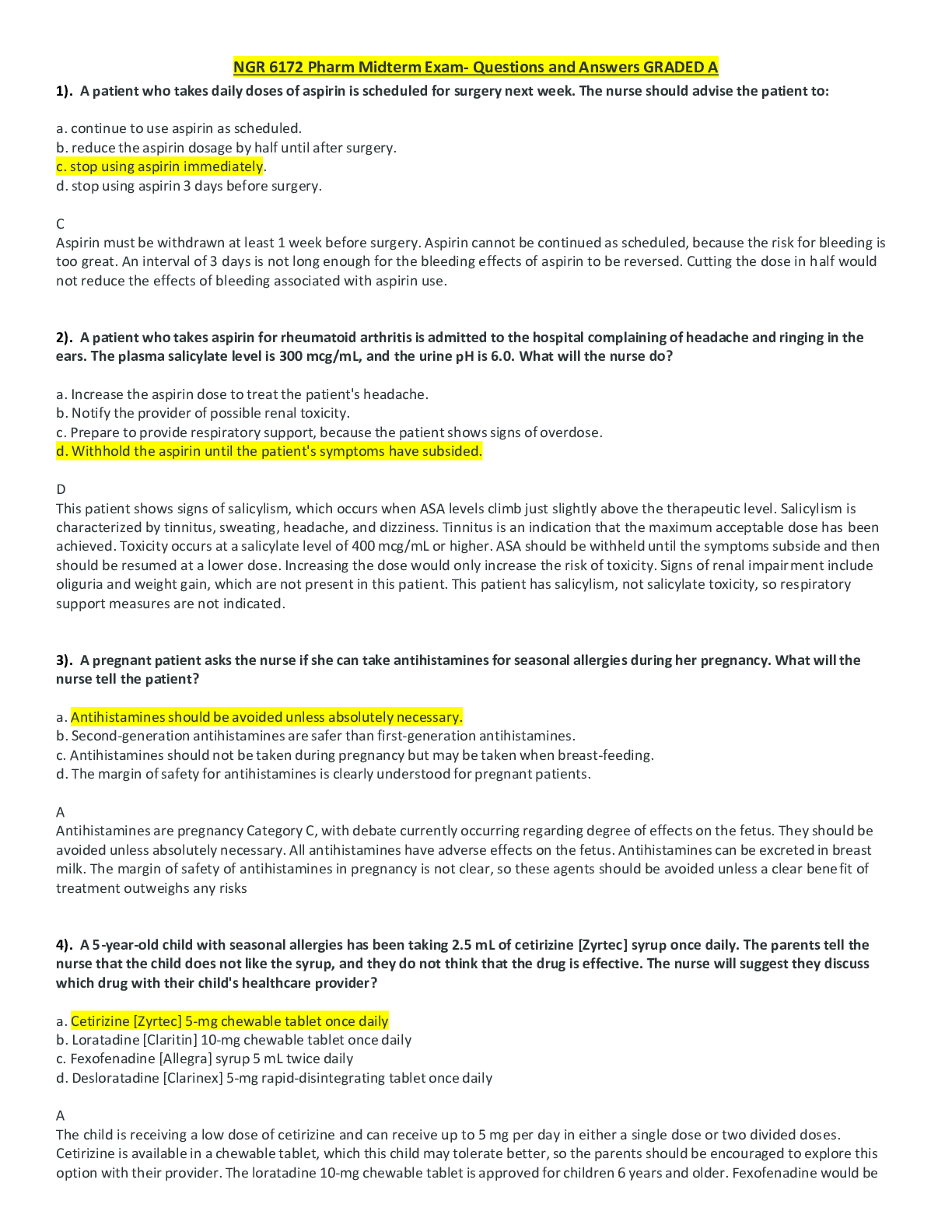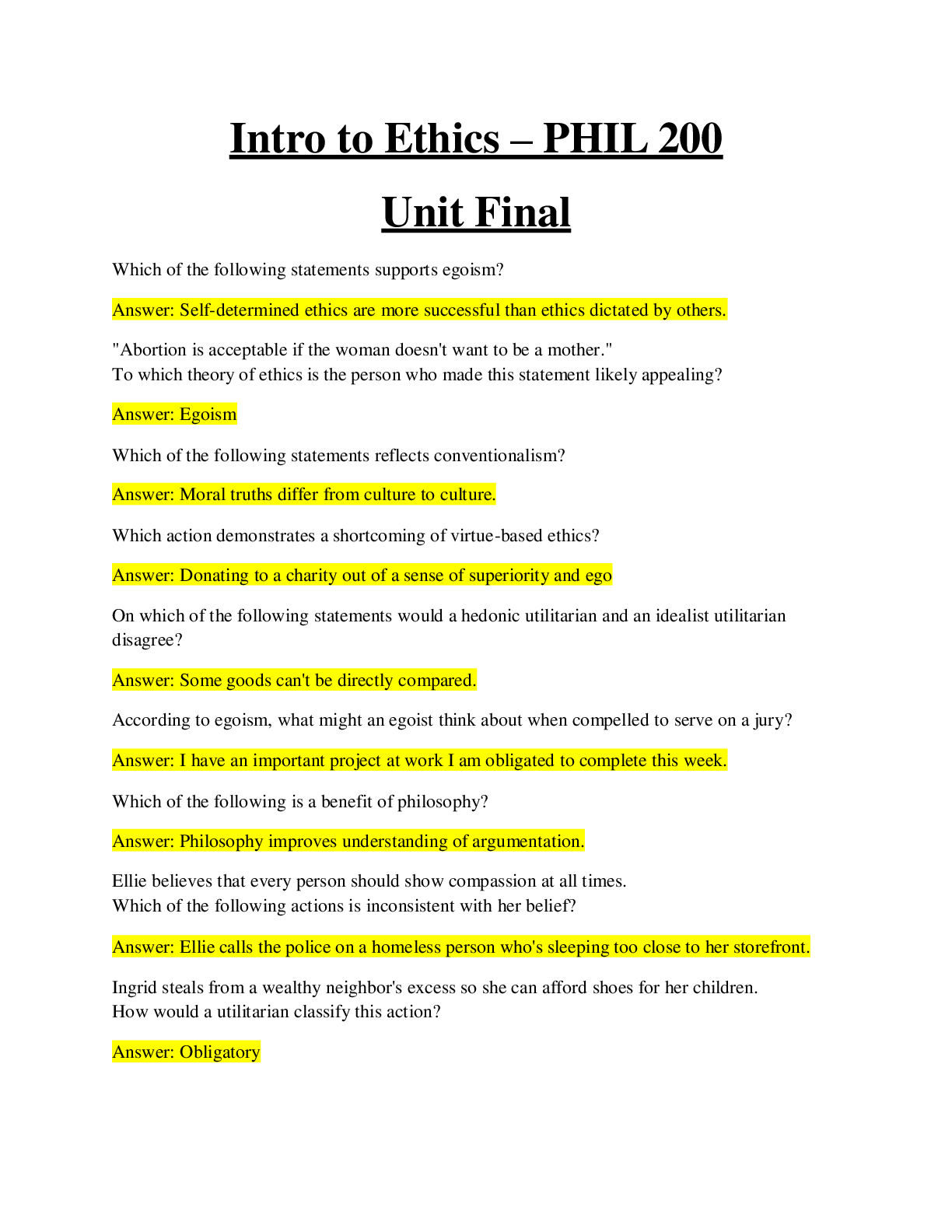ATI_Real_Life_RN_Mental_Health_3.0_Anxiety Disorder (Rated A)
Document Content and Description Below
Individual Name: Institution: Program Type: Amanda Lemus West Coast U Miami BSN BSN Standard Use Time and Score Date/Time Time Use Score Anxiety Disorder 11/11/2020 12:47:51 PM 56 min Satisfac... tory Module Report Real Life RN Mental Health 3.0 Anxiety Disorder Tutorial: Module: Reasoning Scenario Details Anxiety Disorder - Use on 11/11/2020 11:51:35 AM Report Created on: 11/11/2020 12:49 PM EST REP_RSIndv_ModuleReport_1_0 Page 1 of 6 https://www.coursehero.com/file/73610009/ATI-Real-Life-RN-Mental-Health-30-Anxiety-Disorder-1pdf/ This study resource was shared via CourseHero.com Reasoning Scenario Performance Related to Outcomes: *See Score Explanation and Interpretation below for additional details. Body Function Strong Satisfactory Needs Improvement Cognition and Sensation 90.9% 9.1% Oxygenation 100% NCLEX RN Strong Satisfactory Needs Improvement RN Health Promotion and Maintenance 100% RN Psychosocial Integrity 100% RN Pharmacological and Parenteral Therapies 100% RN Reduction of Risk Potential 100% RN Physiological Adaptation 100% QSEN Strong Satisfactory Needs Improvement Safety 100% Patient-Centered Care 100% Evidence Based Practice 50% 50% Decision Log: Optimal Decision Scenario Nurse Tara is admitting Ms. Simpson. Question Nurse Tara is admitting Ms. Simpson. Which of the following is the priority action for Tara to take? Selected Option Assess respiratory status. Rationale The priority action the nurse should take when using the airway, breathing, circulation (ABC) approach to the client is to assess respiratory status of a client who is experiencing shortness of breath and tachypnea. Optimal Decision Scenario Nurse Tara is deciding on which assessment scale to use with Ms. Simpson. Question Nurse Tara is assessing Ms. Simpson. Which of the following assessment scales is an appropriate tool for Tara to use? Selected Option Hamilton-A Report Created on: 11/11/2020 12:49 PM EST REP_RSIndv_ModuleReport_1_0 Page 2 of 6 https://www.coursehero.com/file/73610009/ATI-Real-Life-RN-Mental-Health-30-Anxiety-Disorder-1pdf/ This study resource was shared via CourseHero.com Rationale The nurse should use the Hamilton-A assessment scale to assess anxiety. The client has shortness of breath, chest pain, headaches, restlessness, and trembling. Optimal Decision Scenario Nurse Tara has completed the Hamilton-A assessment of Ms. Simpson. Question Nurse Tara completes the Hamilton-A assessment of Ms. Simpson and determines her score to be 26. Which of the following is an appropriate action for the nurse to take? Selected Option Obtain a prescription for lorazepam (Ativan). Rationale A score of 26 on the Hamilton-A assessment indicates a severe level of anxiety. Therefore, obtaining a prescription for lorazepam (Ativan) is appropriate. Clients who have a severe level of anxiety should receive a short-acting benzodiazepine, such as lorazepam, as an anxiolytic agent. Scenario Nurse Tara is calling the provider for lorazepam (Ativan). Question Nurse Tara is preparing to call the provider. List the findings that the nurse includes when giving report using the SBAR format. (Fill in the blank and click on the submit button when you are finished.) Selected Option Ms. Simpson is a 22 year old African-American female admitted to the inpatient mental health unit for anxiety. She is restless and fidgety, has poor concentration, and has been experiencing chest pain and shortness of breath. She has a history of generalized anxiety disorder and has previously taken paroxetine 20mg PO daily, but has not been taking it for approximately 2 weeks. Her vital signs from report at 0745 were: HR 115, BP 148/76, RR 32, O2 96% on room air, and temperature 37.0C. Her score on the Hamilton A scale is 26, and she has been unable to focus on answering questions due to her severe level of anxiety. She continues to pace, wring her hands, and rock when sitting. I am calling to request a prescription for lorazepam Rationale S (Situation) = Ms. Simpson is a 22-year-old African-American female admitted to the inpatient mental health unit for anxiety. She is restless and fidgety, has poor concentration, and has been experiencing chest pain and shortness of breath. B (Background) = She has a history of generalized anxiety disorder and has previously taken paroxetine 20 mg PO daily, but has not been taking it for approximately 2 weeks.A (Assessment)= Her vital signs from report at 0745 were: heart rate 115, blood pressure 148/76, respirations 32, oxygen saturation 96% on room air, and temperature 37.0 degrees C (98.6 degrees F). Her score on the Hamilton A scale is 26, and she has been unable to focus on answering questions due to her severe level of anxiety. She continues to pace, wring her hands, and rock when sitting.R (Recommendation) = I am calling to request a prescription for lorazepam. Optimal Decision Scenario Nurse Tara is calculating the dose for Lorazepam (Ativan). Question Nurse Tara is calculating the dose of lorazepam (Ativan). Available is lorazepam 4 mg/mL. How many mL should the nurse administer? (Round the answer to the nearest tenth.) Report Created on: 11/11/2020 12:49 PM EST REP_RSIndv_ModuleReport_1_0 Page 3 of 6 https://www.coursehero.com/file/73610009/ATI-Real-Life-RN-Mental-Health-30-Anxiety-Disorder-1pdf/ This study resource was shared via CourseHero.com Selected Option 0.5 Rationale Follow these steps for the Ratio and Proportion method of calculation: Step 1: What is the unit of measurement the nurse should calculate? mL Step 2: What is the dose the nurse should administer? Dose to administer = Desired 2 mg Step 3: What is the dose available? Dose available = Have 4 mg Step 4: Should the nurse convert the units of measurement? No Step 5: What is the quantity of the dose available? 1 mL Step 6: Set up an equation and solve for X. HaveDesired =  QuantityX4 mg2 mg = ف mLX mL X mL = 0.5mL Step 7: Round if necessary. Step 8: Determine whether the amount to administer makes sense. If there are 4 mg/mL and the amount prescribed is 2 mg, it makes sense to administer 0.5 mL. The nurse should administer lorazepam 0.5 mL IM. Follow these steps for the Desired Over Have method of calculation: Step 1: What is the unit of measurement the nurse should calculate? mL Step 2: What is the dose the nurse should administer? Dose to administer = Desired 2 mg Step 3: What is the dose available? Dose available = Have 4 mg Step 4: Should the nurse convert the units of measurement? No Step 5: What is the quantity of the dose available? 1 mL Step 6: Set up an equation and solve for X. Desired × QuantityX =  Have2 mg × 1 mLX mL = ل mg X mL = 0.5 mL Step 7: Round if necessary. Step 8: Determine whether the amount to administer makes sense. If there are 4 mg/mL and the amount prescribed is 2 mg, it makes sense to administer 0.5 mL. The nurse should administer lorazepam 0.5 mL IM. Follow these steps for the Dimensional Analysis method of calculation: Step 1: What is the unit of measurement the nurse should calculate? (Place the unit of measure being calculated on the left side of the equation.) X mL = Step 2: Determine the ratio that contains the same unit as the unit being calculated. (Place the ratio on the right side of the equation, ensuring that the unit in the numerator matches the unit being calculated.) 1 mLX mL = ل mg Step 3: Place any remaining ratios that are relevant to the item on the right side of the equation, along with any needed conversion factors, to cancel out unwanted units of measurement. 1 mL2 mgX mL =   × ل mgx mL Step 4: Solve for X. X mL = 0.5 mL Step 5: Round if necessary. Step 6: Determine whether the amount to administer makes sense. If there are 4 mg/mL and the amount prescribed is 2 mg, it makes sense to administer 0.5 mL. The nurse should administer lorazepam 0.5 mL IM. Optimal Decision Scenario Nurse Tara is initiating therapeutic communication with Ms. Simpson. Report Created on: 11/11/2020 12:49 PM EST REP_RSIndv_ModuleReport_1_0 Page 4 of 6 https://www.coursehero.com/file/73610009/ATI-Real-Life-RN-Mental-Health-30-Anxiety-Disorder-1pdf/ This study resource was shared via CourseHero.com Question Nurse Tara is initiating therapeutic communication with Ms. Simpson. Which of the following video clips demonstrates an appropriate interaction between the nurse and the client? Selected Option Video|05cfe016a9854955a5e2006a654815d0 Rationale Engaged and active listening, including direct eye contact, are key principles of effective communication and will assist in building a rapport with the client. Optimal Decision Scenario Nurse Tara is communicating with Ms. Simpson. Question Nurse Tara is communicating with Ms. Simpson. Which of the following is an appropriate action for Tara to take? Selected Option Restate the concerns voiced by Ms. Simpson. Rationale Restating the client’s concerns allows for exploration and clarification of the client’s statements. Optimal Decision Scenario Nurse Tara is exploring coping skills with Ms. Simpson. Question Nurse Tara is listening to Ms. Simpson while she describes the stressors that contribute to her anxiety. Which of the following coping mechanisms is Ms. Simpson exhibiting? (Select all that apply.) Selected Ordering DenialDisplacementRationalizing Rationale Splitting is the inability to blend both the positive and negative qualities of self. The client knowing that her boyfriend will return is an example of denial. Denial involves the conscious effort of not thinking about an unpleasant event or occurrence that is causing stress. The client blaming the boyfriend’s drinking and gambling behavior to be the cause of her inability to pay rent is an example of displacement. Displacement happens when there is a transfer of feelings about an individual or circumstance to another person or object that is uninvolved in the situation. The client stating that she will be fine without assistance is an example of rationalization. Rationalization is the belief in or acting upon an idea that is unrealistic in order to satisfy the response of the communicator and the listener. Regression involves the acting out behaviors of an individual at an earlier stage in life. Optimal Decision Scenario Nurse Tara is discussing Ms. Simpson’s most stressful situation. Question Nurse Tara is discussing Ms. Simpson’s most stressful situation. Which of the following actions should Tara take first? Selected Option Continue to gather more information regarding finances. Rationale The first action the nurse should take using the nursing process is to collect data from the client. Optimal Decision Scenario Nurse Tara has discovered Ms. Simpson’s self-injury. Report Created on: 11/11/2020 12:49 PM EST REP_RSIndv_ModuleReport_1_0 Page 5 of 6 https://www.coursehero.com/file/73610009/ATI-Real-Life-RN-Mental-Health-30-Anxiety-Disorder-1pdf/ This study resource was shared via CourseHero.com Question Nurse Tara has discovered Ms. Simpson’s self-injury. Which of the following thought processes is most likely a reflection of Ms. Simpson’s behavior? Selected Option Alleviation of psychological pain Rationale Self-injury in this client is a mode of alleviating psychological pain by causing physical pain. Optimal Decision Scenario Nurse Tara is providing medication teaching. Question Nurse Tara is providing medication teaching regarding escitalopram (Lexapro). Which of the following statements should Tara include in the teaching? Selected Option "You should report increased thoughts of suicide." Rationale Clients, especially children and young adults, who start therapy with escitalopram are at increased risk for suicidal ideation. The nurse should report changes in behavior to the provider. Scenario Nurse Tara is explaining Ms. Simpson’s diagnosis. Question Nurse Tara is explaining Ms. Simpson’s diagnosis. Which of the following statements should Tara include in the teaching? (Select all that apply.) Selected Ordering "Interventions are based on the degree of anxiety you are experiencing.""You can experience four levels of anxiety.""It is common to have manic and depressive episodes with anxiety disorders." Rationale Treatment of anxiety is individualized to degree of anxiety the client is experiencing. The four levels of anxiety include mild, moderate, severe, and panic. Manic and depressive episodes are key features in bipolar disorder. It is common to perform repetitive behaviors in order to cope with anxiety, such as continual hand washing. Grandiose thoughts are common in clients experiencing delusions, and also occur in a manic phase of bipolar disorder. Optimal Decision Scenario Nurse Tara is teaching Ms. Simpson about anxiety . Question Nurse Tara is teaching Ms. Simpson about anxiety. Which of the following indicate Ms. Simpson understands the teaching? Selected Option Uses relaxation techniques Rationale Using relaxation techniques is an indicator of positive self-control. Additional indicators include monitoring of anxiety levels and environmental distractions and the ability to maintain restful sleep. Report Created on: 11/11/2020 12:49 PM EST REP_RSIndv_ModuleReport_1_0 Page 6 of 6 https://www.coursehero.com/file/73610009/ATI-Real-Life-RN-Mental-Health-30-Anxiety-Disorder-1pdf/ This study resource was shared via CourseHero.com Page 1 of 3 Individual Report – Score Explanation and Interpretation Reasoning Scenario Information: Reasoning Scenario Information provides the date, time and duration of use, along with the score earned for each attempt. A Reasoning Scenario Performance score of Strong, Satisfactory, or Needs Improvement is provided for each attempt. This information is also provided for the Optimal Decision Mode if it has been enabled. Reasoning Scenario Performance Scores: Strong Exhibits optimal reasoning that results in positive outcomes in the care of clients and resolution of problems. Satisfactory Exhibits reasoning that results in mildly helpful or neutral outcomes in the care of clients and resolution of problems. Needs Improvement Exhibits reasoning that results in harmful or detrimental outcomes in the care of clients and resolution of problems. Reasoning Scenario Performance Related to Outcomes: A clinical reasoning performance score related to each outcome is provided. Outcomes associated with student responses are listed in the report. The number across from each outcome indicates the percentage of responses associated with the level of performance of that outcome. NCLEX® Client Need Categories: Management of Care Providing integrated, cost‐effective care to clients by coordinating, supervising, and/or collaborating with members of the multi‐disciplinary health care team. Safety and Infection Control Incorporating preventative safety measures in the provision of client care that provides for the health and well‐being of clients, significant others, and members of the health care team. Health Promotion and Maintenance Providing and directing nursing care that encourages prevention and early detection of illness, as well as the promotion of health. Psychosocial Integrity Promoting mental, emotional, and social well‐being of clients and significant others through the provision of nursing care. Basic Care and Comfort Promoting comfort while helping clients perform activities of daily living. Pharmacological and Parenteral Therapies Providing and directing administration of medication, including parenteral therapy. Reduction of Risk Potential Providing nursing care that decreases the risk of clients developing health‐ related complications. https://www.coursehero.com/file/73610009/ATI-Real-Life-RN-Mental-Health-30-Anxiety-Disorder-1pdf/ This study resource was shared via CourseHero.com Page 2 of 3 Physiological Adaptation Providing and directing nursing care for clients experiencing physical illness. Quality and Safety Education for Nurses (QSEN) Safety The minimization of risk factors that could cause injury or harm while promoting quality care and maintaining a secure environment for clients, self, and others. Patient‐Centered Care The provision of caring and compassionate, culturally sensitive care that is based on a client’s physiological, psychological, sociological, spiritual, and cultural needs, preferences, and values Evidence Based Practice The use of current knowledge from research and other credible sources, upon which clinical judgment and client care are based. Informatics The use of information technology as a communication and information gathering tool that supports clinical decision making and scientifically based nursing practice. Quality Improvement Care related and organizational processes that involve the development and implementation of a plan to improve health care services and better meet the needs of clients. Teamwork and Collaboration The delivery of client care in partnership with multidisciplinary members of the health care team, to achieve continuity of care and positive client outcomes. Body Function Cardiac Output and Tissue Perfusion The anatomical structures (heart, blood vessels, and blood) and body functions that support adequate cardiac output and perfusion of body tissues. Cognition and Sensation The anatomical structures (brain, central and peripheral nervous systems, eyes and ears) and body functions that support perception, interpretation, and response to internal and external stimuli. Excretion The anatomical structures (kidney, ureters, and bladder) and body functions that support filtration and excretion of liquid wastes, regulate fluid and electrolyte and acid‐base balance. Immunity The anatomic structures (spleen, thymus, bone marrow, and lymphatic system) and body functions related to inflammation, immunity, and cell growth. Ingestion, Digestion, Absorption and Elimination The anatomical structures (mouth, esophagus, stomach, gall bladder, liver, small and large bowel, and rectum) and body functions that support ingestion, digestion, and absorption of food and elimination of solid wastes from the body. Integument The anatomical structures (skin, hair, and nails) and body functions related to protecting the inner organs from the external environment and injury. Mobility The anatomical structures (bones, joints, and muscles) and body functions that support the body and provide its movement. https://www.coursehero.com/file/73610009/ATI-Real-Life-RN-Mental-Health-30-Anxiety-Disorder-1pdf/ This study resource was shared via CourseHero.com Page 3 of 3 Oxygenation The anatomical structures (nose, pharynx, larynx, trachea, and lungs) and body functions that support adequate oxygenation of tissues and removal of carbon dioxide. Regulation and Metabolism The anatomical structures (pituitary, thyroid, parathyroid, pancreas, and adrenal glands) and body functions that regulate the body’s internal environment. Reproduction The anatomical structures (breasts, ovaries, fallopian tubes, uterus, vagina, vulva, testicles, prostate, scrotum, and penis) and body functions that support reproductive functions. Decision Log Information related to each question answered in a scenario attempt is listed in the report. A brief description of the scenario, question, selected option and rationale for that option are provided for each question answered. The words “Optimal Decision” appear next to the question when the most optimal option was selected. The rationale for each selected option may be used to guide remediation. A variety of learning resources may be used in the review process, including related ATI Review Modules. https://www.coursehero.com/file/73610009/ATI-Real-Life-RN-Mental-Health-30-Anxiety-Disorder-1pdf/ This study resource was shared via CourseHero.com Powered by TCPDF (www.tcpdf.org) [Show More]
Last updated: 1 year ago
Preview 1 out of 9 pages

Reviews( 1 )

by Deisy Ramirez · 3 years ago
great
Recommended For You
*NURSING> EXAM > ENPC Test Questions & Answers (All)

ENPC Test Questions & Answers
ENPC Test Questions & Answers-An unresponsive 2-year-old child was found by his mother with a bottle labeled "Elavil 50 mg" by his side. Which piece of information is important to obtain from his moth...
By PROF , Uploaded: Apr 25, 2024
$9.5
Religious Studies> EXAM > CWV TOPIC 2 QUIZ. QUESTIONS AND ANSWERS LATEST UPDATED. (Score 100%) (All)

CWV TOPIC 2 QUIZ. QUESTIONS AND ANSWERS LATEST UPDATED. (Score 100%)
CWV TOPIC 2 QUIZ QUESTIONS AND ANSWERS LATEST UPDATED
By ELIANA , Uploaded: Aug 01, 2022
$9
ATI MED SURG PROCTORED> EXAM > Med Surg ATI Proctored Exam Test Bank 2023/2024 With NGN (All)

Med Surg ATI Proctored Exam Test Bank 2023/2024 With NGN
Med Surg ATI Proctored Exam Test Bank 2023/2024 With NGN Med Surg ATI Proctored Exam Test Bank 2023/2024 With NGN Med Surg ATI Proctored Exam Test Bank 2023/2024 With NGN Med Surg ATI Proctored E...
By EXAMHUB SOLUTIONS , Uploaded: Apr 15, 2024
$30.5
NURSING.> EXAM > ATI RN CUSTOM; MENTAL HEALTH NEXT GEN (All)

ATI RN CUSTOM; MENTAL HEALTH NEXT GEN
ATI RN CUSTOM; MENTAL HEALTH NEXT GEN ATI RN CUSTOM; MENTAL HEALTH NEXT GEN ATI RN CUSTOM; MENTAL HEALTH NEXT GEN ATI RN CUSTOM; MENTAL HEALTH NEXT GEN ATI RN CUSTOM; MENTAL HEALTH NEXT GE...
By EXAMHUB SOLUTIONS , Uploaded: Apr 05, 2024
$45.5
ATI Med Surg> EXAM > RN ATI MED SURG ALTERATIONS IN KIDNEY FUNCTION AND ELIMINATION ASSESSMENT. (All)

RN ATI MED SURG ALTERATIONS IN KIDNEY FUNCTION AND ELIMINATION ASSESSMENT.
RN ATI MED SURG ALTERATIONS IN KIDNEY FUNCTION AND ELIMINATION ASSESSMENT. RN ATI MED SURG ALTERATIONS IN KIDNEY FUNCTION AND ELIMINATION ASSESSMENT. RN ATI MED SURG ALTERATIONS IN KIDNEY FUNCTI...
By EXAMHUB SOLUTIONS , Uploaded: Apr 10, 2024
$28.5
Nutrition> EXAM > Nutrition Through the Life Cycle EXAM 2. 50 Questions & Answers. (Score 100%) (All)

Nutrition Through the Life Cycle EXAM 2. 50 Questions & Answers. (Score 100%)
Nutrition Through the Life Cycle EXAM 2 Latest
By Academic mines , Uploaded: Apr 27, 2023
$10
*NURSING> EXAM > NGR 6172 Pharm Midterm Exam- Questions and Answers. Score 98% (All)

NGR 6172 Pharm Midterm Exam- Questions and Answers. Score 98%
NGR 6172 Pharm Midterm Exam- Questions and Answers GRADED A-1). A patient who takes daily doses of aspirin is scheduled for surgery next week. The nurse should advise the patient to: a. continue to...
By PROF , Uploaded: Feb 01, 2022
$11
Philosophy> EXAM > PHL 200 Intro to Ethics Unit 3 - Score 100% (All)

PHL 200 Intro to Ethics Unit 3 - Score 100%
PHL 200 Intro to Ethics Unit 3 For a utilitarian, which consideration is most important? Why is utilitarianism an objectivist or relativist theory? Which of the following considerations is important f...
By Ajay25 , Uploaded: Jan 04, 2022
$8
Philosophy> EXAM > PHL 200 Intro to Ethics Unit 2 -Score 100% (All)

PHL 200 Intro to Ethics Unit 2 -Score 100%
PHL 200 Intro to Ethics Unit 2 Which of the following statements about divine command theory is true? Norman learns from his pastor that God commands people to love one another. Thus according to divi...
By Ajay25 , Uploaded: Jan 04, 2022
$8
Philosophy> EXAM > PHL 200 Intro to Ethics Unit Final. Score 100% (All)

PHL 200 Intro to Ethics Unit Final. Score 100%
PHL 200 Intro to Ethics Unit Final Which of the following statements supports egoism? "Abortion is acceptable if the woman doesn't want to be a mother." To which theory of ethics is the person who mad...
By Ajay25 , Uploaded: Jan 04, 2022
$8
Document information
Connected school, study & course
About the document
Uploaded On
Mar 22, 2021
Number of pages
9
Written in
Additional information
This document has been written for:
Uploaded
Mar 22, 2021
Downloads
1
Views
196





